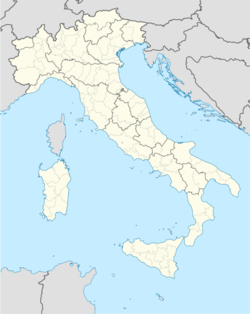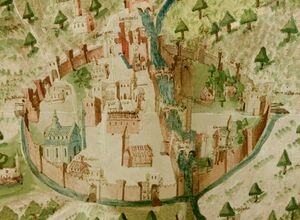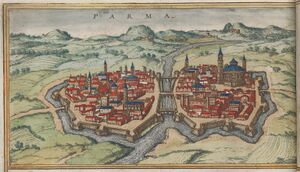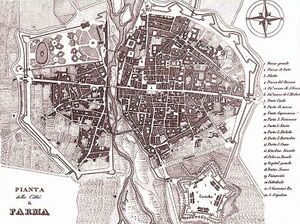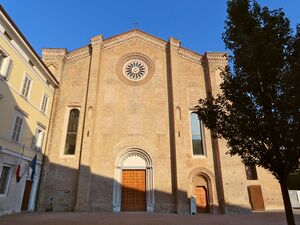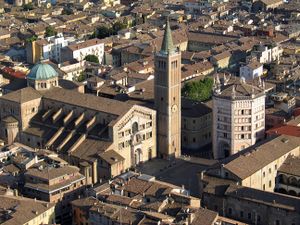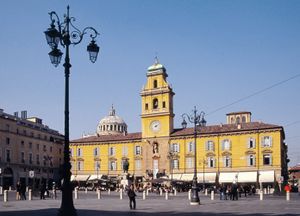پارما
Parma
Pärma (إميلية) | |
|---|---|
| Comune di Parma | |
من أعلى اليسار: Monument to Victory, Palazzo del Governatore, Parma Cathedral, Palazzo della Pilotta with Monumento al Partigiano, Palazzo del Giardino in Parco Ducale, Baptistery of Parma, aerial view from the Baptistery | |
| الإحداثيات: 44°48′05.3″N 10°19′40.8″E / 44.801472°N 10.328000°E | |
| البلد | إيطاليا |
| المنطقة | Emilia-Romagna |
| المقاطعة | پارما (PR) |
| Frazioni | See list |
| الحكومة | |
| • العمدة | Federico Pizzarotti ([[قائمة الأحزاب السياسية في إيطاليا|Independent]]) |
| المساحة | |
| • الإجمالي | 260٫77 كم² (100٫68 ميل²) |
| المنسوب | 55 m (180 ft) |
| التعداد (30 June 2018)[1] | |
| • الإجمالي | 197٬132 |
| • الكثافة | 760/km2 (2٬000/sq mi) |
| صفة المواطن | Parmigiano |
| منطقة التوقيت | UTC+1 (CET) |
| • الصيف (التوقيت الصيفي) | UTC+2 (CEST) |
| الرمز البريدي | 43121-43126 |
| مفتاح الهاتف | 0521 |
| Patron saint | Sant'Ilario di Poitiers, Sant'Onorato, San Rocco |
| يوم القديس | January 13 |
| الموقع الإلكتروني | Official website |
پارما مدينة في شمال إيطاليا ضمن إقليم إيميليا-رومانيا، عاصمة مقاطعة پارما ، تقغ على نهر بو أسسها الرومان عام 183 م سكانها 176,000 نسمة .
تأسست بارما في عهد الجمهورية الرومانية (509 ق.م. – 27 ق.م.) وتحوي كنوزًا أدبية وفنية كثيرة. شيدت بها كاتدرائية في القرن الحادي عشر الميلادي، وهي نموذج لفن العمارة اللومباردي الرومانسكي. وقد زين التشكيلي كوريجيو قبتها بلوحة جصية تعرف باسم رفع العذراء.
أسست جامعة پارما في عام 1502م وتشتهر المنطقة المحيطة ببارما بصناعة جبن پارميزان.
التاريخ
![]() الإمبراطورية الرومانية 27 BC–285 AD
الإمبراطورية الرومانية 27 BC–285 AD
![]() الإمبراطورية الرومانية الغربية 285–476
الإمبراطورية الرومانية الغربية 285–476
![]() مملكة أودواكر 476–493
مملكة أودواكر 476–493
![]() مملكة القوط الشرقيين 493–553
مملكة القوط الشرقيين 493–553
![]() الإمبراطورية الرومانية الشرقية 553-568
الإمبراطورية الرومانية الشرقية 553-568
![]() المملكة اللومباردية 568–773
المملكة اللومباردية 568–773
![]() الإمبراطورية الكارولنجية 773–781
الإمبراطورية الكارولنجية 773–781
![]() Regnum Italiae 781–1014
Regnum Italiae 781–1014
![]() الإمبراطورية الرومانية المقدسة 1014–1114
الإمبراطورية الرومانية المقدسة 1014–1114
![]() Free Commune 1114–1341
Free Commune 1114–1341
![]() دوقية ميلانو 1341–1513
دوقية ميلانو 1341–1513
![]() الدويلات الپاپوية 1513–1554
الدويلات الپاپوية 1513–1554
![]() دوقية پارما 1554–1808
دوقية پارما 1554–1808
![]() الإمبراطورية الفرنسية الأولى 1808–1814
الإمبراطورية الفرنسية الأولى 1808–1814
![]() دوقية پارما وپيانشتزا وگواستالا 1814–1848
دوقية پارما وپيانشتزا وگواستالا 1814–1848
![]() دوقية پارما 1851–1859
دوقية پارما 1851–1859
![]() المقاطعات المتحدة في
المقاطعات المتحدة في
إيطاليا الوسطى 1859–1860
![]() مملكة إيطاليا 1861–1946
مملكة إيطاليا 1861–1946
ما قبل التاريخ
Parma was already a built-up area in the Bronze Age. In the current position of the city rose a terramare.[2] The "terramare" (marl earth) were ancient villages built of wood on piles according to a defined scheme and squared form; constructed on dry land and generally in proximity to the rivers. During this age (between 1500 BC and 800 BC) the first necropolis (on the sites of the present-day Piazza Duomo and Piazzale della Macina) were constructed.
القِدم
The city was most probably founded and named by the Etruscans, for a parma or palma (circular shield) was a Latin borrowing, as were many Roman terms for particular arms, and the names Parmeal, Parmni and Parmnial appear in Etruscan inscriptions. Diodorus Siculus[3] reported that the Romans had changed their rectangular shields for round ones, imitating the Etruscans. Whether the Etruscan encampment acquired its name from its round shape, like a shield, or from its metaphorical function as a shield against the Gauls to the north, remains uncertain.
The Roman colony was founded in 183 BC, together with Mutina (Modena); 2,000 families were settled. Parma had a certain importance as a road hub over the Via Aemilia and the Via Claudia. It had a forum, in what is today the central Garibaldi Square. In April 43 BC the city was destroyed.[4] Subsequently Augustus rebuilt it. During the Roman Empire, it gained the title of Julia for its loyalty to the imperial house.
Attila sacked the city in 452,[5] and the Germanic king Odoacer later gifted it to his followers. During the Gothic War, however, Totila destroyed it. It was then part of the Byzantine Exarchate of Ravenna (changing its name to Chrysopolis, "Golden City", probably due to the presence of the imperial treasury) and, from 569, of the Lombard Kingdom of Italy. During the Middle Ages, Parma became an important stage of the Via Francigena, the main road connecting Rome to Northern Europe; several castles, hospitals and inns were built in the following centuries to host the increasing number of pilgrims who passed by Parma and Fidenza, following the Apennines via Collecchio, Berceto and the Corchia ranges before descending the Passo della Cisa into Tuscany, heading finally south toward Rome.
The city had a medieval Jewish community.[6] The Palatine Library houses the largest collection of Hebrew manuscripts in Italy, and the second-largest in the world after the Bodleian Library in Oxford.[7]
العصور الوسطى
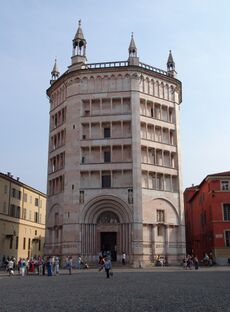
Under Frankish rule, Parma became the capital of a county in 774. Like most northern Italian cities, it was nominally a part of the Holy Roman Empire created by Charlemagne, but locally ruled by its bishops, the first being Guibodus. In the subsequent struggles between the Papacy and the Empire, Parma was usually a member of the Imperial party. Two of its bishops became antipopes: Càdalo, founder of the cathedral, as Honorius II; and Guibert, as Clement III. An almost independent commune was created around 1140; a treaty between Parma and Piacenza of 1149 is the earliest document of a comune headed by consuls.[8] After the Peace of Constance in 1183 confirmed the Italian communes' rights of self-governance, long-standing quarrels with the neighbouring communes of Reggio Emilia, Piacenza and Cremona became harsher, with the aim of controlling the vital trading line over the Po River.
The struggle between Guelphs and Ghibellines was a feature of Parma too. In 1213, her podestà was the Guelph Rambertino Buvalelli. Then, after a long stance alongside the emperors, the Papist families of the city gained control in 1248. The city was besieged in 1247–48 by Emperor Frederick II, who was however crushed in the battle that ensued.
By 1328, Rolando de' Rossi was made signore of Parma. In 1331, the city submitted to King John of Bohemia. Parma fell under the control of Milan in 1341. After a short-lived period of independence under the Terzi family (1404–1409), the Sforza imposed their rule (1440–1449) through their associated families of Pallavicino, Rossi, Sanvitale and Da Correggio. These created a kind of new feudalism, building towers and castles throughout the city and the land. These fiefs evolved into truly independent states: the Landi governed the higher Taro's valley from 1257 to 1682. The Pallavicino seignory extended over the eastern part of today's province, with the capital in Busseto. Parma's territories were an exception for Northern Italy, as its feudal subdivision frequently continued until more recent years. For example, Solignano was a Pallavicino family possession until 1805, and San Secondo belonged to the Rossi well into the 19th century.
العصر الحديث
Between the 14th and the 15th centuries, Parma was at the centre of the Italian Wars. The Battle of Fornovo was fought in its territory. The French held the city in 1500–1521, with a short Papal parenthesis in 1512–1515. After the foreigners were expelled, Parma belonged to the Papal States until 1545.
In that year the Farnese pope, Paul III, detached Parma and Piacenza from the Papal States and gave them as a duchy to his illegitimate son, Pier Luigi Farnese, whose descendants ruled in Parma until 1731, when Antonio Farnese, last male of the Farnese line, died. In 1594 a constitution was promulgated, the University enhanced and the Nobles' College founded. The war to reduce the barons' power continued for several years: in 1612 Barbara Sanseverino was executed in the central square of Parma, together with six other nobles charged of plotting against the duke. At the end of the 17th century, after the defeat of Pallavicini (1588) and Landi (1682) the Farnese duke could finally hold with firm hand all Parmense territories. The castle of the Sanseverino in Colorno was turned into a luxurious summer palace by Ferdinando Bibiena.
In the Treaty of London (1718) it was promulgated that the heir to the combined Duchy of Parma and Piacenza would be Elisabeth Farnese's elder son with Philip V of Spain, Don Carlos. In 1731, the fifteen-year-old Don Carlos became Charles I Duke of Parma and Piacenza, at the death of his childless great uncle Antonio Farnese. In 1734, Charles I conquered the kingdoms of Naples and Sicily, and was crowned as the King of Naples and Sicily on 3 July 1735, leaving the Duchy of Parma to his brother Philip (Filippo I di Borbone-Parma). All the outstanding art collections of the duke's palaces of Parma, Colorno and Sala Baganza were moved to Naples.
Parma was under French influence after the Peace of Aachen (1748). Parma became a modern state with the energetic action of prime minister Guillaume du Tillot. He created the bases for a modern industry and fought strenuously against the church's privileges. The city lived a period of particular splendour: the Biblioteca Palatina (Palatine Library), the Archaeological Museum, the Picture Gallery and the Botanical Garden were founded, together with the Royal Printing Works directed by Giambattista Bodoni, aided by the Amoretti Brothers as skilled and inspired punchcutters.
العصر الحالي
During the Napoleonic Wars (1802–1814), Parma was annexed to France and made capital of the Taro Department. Under its French name, Parme, it was also created a duché grand-fief de l'Empire for Charles-François Lebrun, duc de Plaisance, the Emperor's Arch-Treasurer, on 24 April 1808 (extinguished in 1926).
After the restoration of the Duchy of Parma by the 1814–15 Vienna Congress, the Risorgimento's upheavals had no fertile ground in the tranquil duchy. In 1847, after Marie Louise, Duchess of Parma's death, it passed again to the House of Bourbon, the last of whom was stabbed in the city and left it to his widow, Luisa Maria of Berry. On 15 September 1859 the dynasty was declared deposed, and Parma entered the newly formed province of Emilia under Luigi Carlo Farini. With the plebiscite of 1860 the former duchy became part of the unified Kingdom of Italy.
The loss of the capital role provoked an economic and social crisis in Parma. It started to recover its role of industrial prominence after the railway connection with Piacenza and Bologna of 1859, and with Fornovo and Suzzara in 1883. Trade unions were strong in the city, in which a notable General Strike was declared from 1 May to 6 June 1908. The struggle with Fascism had its most dramatic moment in August 1922, when the regime officer Italo Balbo attempted to enter the popular quarter of Oltretorrente. The citizens organized into the Arditi del Popolo ("The people's daring ones") and pushed back the squadristi. This episode is considered the first example of Resistance in Italy.
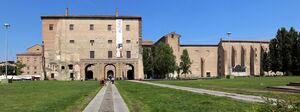
During World War II, Parma was a strong centre of partisan resistance. The train station and marshalling yards were targets for high altitude bombing by the Allies in the spring of 1944. Much of the Palazzo della Pilotta, situated not far (half a mile) from the train station, was destroyed. Along with it the Teatro Farnese and part of the Biblioteca Palatina were destroyed by Allied bombs; some 21,000 volumes of the library's collection were lost. Several other monuments were also damaged: Palazzo del Giardino, Steccata and San Giovanni churches, Palazzo Ducale, Paganini theater and the monument to Verdi. However, Parma did not see widespread destruction during the war. Parma was liberated from the German occupation (1943–1945) on 26 April 1945 by the partisan resistance and the Brazilian Expeditionary Force.[9]
الجغرافيا
المناخ
In Parma, the average annual high temperature is 17 °C (63 °F), the annual low temperature is 9 °C (48 °F), and the annual precipitation is 777 ميليمتر (30.59 بوصات).
The following data comes from the weather station located at the university in the city center. It is affected by the urban heat island phenomenon. Parma has a mid-latitude, four-season humid subtropical climate (Köppen: Cfa) with heavy continental influences due to the city's inland position. Relatively nearby coastal areas like Genoa have far milder climates with cooler summers and milder winters, with the mountains separating Parma from the Mediterranean Sea acting as a barrier to the sea air. The city receives approximately 45 cm of snow each winter.
| بيانات المناخ لـ پارما (وسط المدينة) | |||||||||||||
|---|---|---|---|---|---|---|---|---|---|---|---|---|---|
| الشهر | ينا | فب | مار | أبر | ماي | يون | يول | أغس | سبت | أكت | نوف | ديس | السنة |
| متوسط القصوى اليومية °س (°ف) | 4.1 (39.4) |
7.5 (45.5) |
13.2 (55.8) |
18.0 (64.4) |
22.8 (73.0) |
27.3 (81.1) |
30.1 (86.2) |
29.3 (84.7) |
24.8 (76.6) |
17.8 (64.0) |
10.3 (50.5) |
5.4 (41.7) |
17.6 (63.7) |
| المتوسط اليومي °س (°ف) | 1.3 (34.3) |
3.9 (39.0) |
8.9 (48.0) |
13.1 (55.6) |
17.6 (63.7) |
21.8 (71.2) |
24.4 (75.9) |
23.9 (75.0) |
19.9 (67.8) |
13.9 (57.0) |
7.6 (45.7) |
2.9 (37.2) |
13.3 (55.9) |
| متوسط الدنيا اليومية °س (°ف) | −1.5 (29.3) |
0.4 (32.7) |
4.5 (40.1) |
8.3 (46.9) |
12.5 (54.5) |
16.3 (61.3) |
18.6 (65.5) |
18.2 (64.8) |
15.0 (59.0) |
10.1 (50.2) |
4.8 (40.6) |
0.4 (32.7) |
9.0 (48.2) |
| متوسط تساقط الأمطار mm (inches) | 57 (2.2) |
55 (2.2) |
65 (2.6) |
76 (3.0) |
73 (2.9) |
56 (2.2) |
37 (1.5) |
48 (1.9) |
67 (2.6) |
96 (3.8) |
84 (3.3) |
73 (2.9) |
777 (30.6) |
| Source: Archivio climatico Enea-Casaccia (1961-1990)[10] | |||||||||||||
المزارات الرئيسية
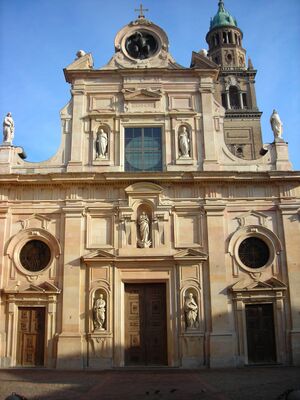

الكنائس
القصور
أخرى
القرى
الديمغرافيا
| ISTAT 1 January 2016[12][13] | ||||
| Parma | Italy | |||
| 18 years old and under | 16.46% | 17.45% | ||
| 65 years old and over | 22.64% | 22.04% | ||
| Foreign Population | 15.91% | 8.29% | ||
| Births/1,000 people | 8.62 b | 8.01 b | ||
(1/1/2016)[13] | |
|---|---|
| Country of birth | Population |
| 4,967 | |
| 3,513 | |
| 2,661 | |
| 2,570 | |
| 1,561 | |
| 1,450 | |
| 1,292 | |
| 1,264 | |
| 1,104 | |
| 938 | |
| 819 | |
الطعام
المدن الشقيقة
 شيجياژوانگ, جمهورية الصين الشعبية
شيجياژوانگ, جمهورية الصين الشعبية ميلواكي، وسكنسن، الولايات المتحدة
ميلواكي، وسكنسن، الولايات المتحدة گوادالاهار، اسبانيا
گوادالاهار، اسبانيا بورگ-ان-برس, فرنسا
بورگ-ان-برس, فرنسا تور, فرنسا
تور, فرنسا ليوبليانا، سلوڤينيا
ليوبليانا، سلوڤينيا ڤورمز, ألمانيا
ڤورمز, ألمانيا سگد, المجر
سگد, المجر مونكتون، كندا
مونكتون، كندا ستكتن، كاليفورنيا، الولايات المتحدة
ستكتن، كاليفورنيا، الولايات المتحدة
الرياضة
متنوعة
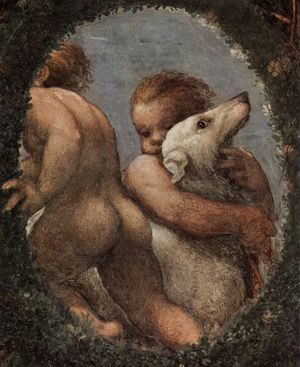
الرسامون والنحاتون من بارما
مشاهير من بارما
انظر أيضا
وصلات خارجية
- The European Food Safety Authority Website
- پارما travel guide from Wikitravel
- The best of Parma
- Parma's view from satellite (Google Earth)
- 360° photos of City of Parma
- ^ خطأ استشهاد: وسم
<ref>غير صحيح؛ لا نص تم توفيره للمراجع المسماةISTAT_PR2016 - ^ "Archaeology in Emilia Romagna page".
- ^ XXII, 2,2; XXVIII, 2,1
- ^ The Letters of Cicero: B.C. 44-43. G. Bell and Sons. 1900.
- ^
Domenico, Roy Palmer (2002). "Parma". The Regions of Italy: A Reference Guide to History and Culture. Westport, Connecticur: Greenwood Publishing Group. p. 93. ISBN 9780313307331. Retrieved 2019-05-05.
Atila the Hun put Parma to the torch in 452, as did Totila the Ostrogoth in the mid-500s. It was rebuilt a number of times as a Lombard capital, the site of a Byzantine treasury, and, from the ninth century, a bishopric.
- ^ Italy's poetic Parma region - "Italy has one of the oldest European Diaspora communities and a Jewish presence has been documented in Rome for more than 2,200 years. However, Jews only arrived in the Emilia-Romagna region during the 13th century."
- ^ Parma - "The Palatine Library is as well home to the largest Italian collection of Hebrew manuscripts, and the second largest in the world after the Bodleian Library in Oxford. The documents were a gift of Maria Luigia Duchess."
- ^ G. Drei, Le Carte degli archivi parmensi del secolo XII (Parma, 1950) doc. no. 194; the genesis of the Parmesan commune is studied by R. Schumann, "Authority and the commune: Parma, 833–1033", (Parma: Deputazione di storia patria, series 2.2, VIII) 1973.
- ^ "Mapa da рrea de operaушes". Pitoresco.com. Archived from the original on 10 April 2008. Retrieved 2009-05-06.
- ^ "Archivio climatico Enea-Casaccia". clisun.casaccia.enea.it. Archived from the original on 3 November 2014.
- ^ "Monastero di San Giovanni, la chiesa" (in الإيطالية).
- ^ خطأ استشهاد: وسم
<ref>غير صحيح؛ لا نص تم توفيره للمراجع المسماةISTAT_Bil2015Tot - ^ أ ب خطأ استشهاد: وسم
<ref>غير صحيح؛ لا نص تم توفيره للمراجع المسماةISTAT_Bil2015Ext
- Pages using gadget WikiMiniAtlas
- Short description is different from Wikidata
- Articles containing إميلية-language text
- Articles containing إيطالية-language text
- Pages using multiple image with auto scaled images
- Coordinates on Wikidata
- Pages using infobox settlement with image map1 but not image map
- Italian commune articles with missing parameters
- پارما
- مدن وبلدات في إميليا-رومانيا
- بلدات جامعية في إيطاليا
- صفحات مع الخرائط
- CS1 الإيطالية-language sources (it)










